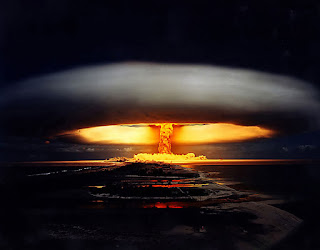How do we know there
is a God?
That is a pretty straightforward question. Conversely, how do we know there is not a
God. A quite good question as well.
One might think if you just opened your eyes and unclogged
your mind, you just might figure it out.
Look in a mirror. No matter what
you might see, you are witnessing a miracle of sorts that cannot be explained
or understood by science, the human body.
Far more complex than a computer could ever be, the body is
a multi-functional mechanism with many physical attributes, including massive
information processing and communications functions, the ability to create and
procreate, even the ability to be born, die, and be resurrected from the dead as
in the case of Jesus of Nazareth.
No other species, organism, or cell can do such a thing, at
least none we have discovered. Yet all
these matters concern the physical body we possess. What about the other non-physical aspects of humans? Things you might call beyond the mind.
There is the Soul, what some might call the golden lifeline
to the Creator. There is also the Spirit,
hovering around you throughout your life waiting for the moment when you are
inspired to remember the Creator within you.
Once you do, the Spirit will infuse you with the Perfect Love of the Creator
that created you in the first place.
So intense was the Creator’s love for you that he created
our existence, the Earth, and the galaxies along with the Sun, Moon, and
Planets. Then gave us His Son, Jesus of
Nazareth, to absolve us of all our sins while on our journey to find our way
home. His Son was pledged to die so that
we might live, not just on Earth, but back in the Kingdom of the Creator.
If you did not know this, perhaps because of an oppressive government
where you live, or as a result of the varying beliefs of the many religious
institutions competing for your soul, not to mention the tithing, then you
should check it out.
Science and technology may rule the Earth as we know it today,
but they have no clue how humans, the Earth, or the never-ending multitudes of
new galaxies being discovered were created.
One must remember, most of creation had to exist before humans arrived,
and the first generation of humans on Earth in fact were aliens that were not
born here, they were created here.
The Age of Technology and the Machine (code name for massive
computing power and Artificial Intelligence), may be upon us but it need not
create our future, we are entirely capable of creating it ourselves, or at
least we used to be.
So, we have the digital evolution morphing into a cyber
revolution. Artificial Intelligence
programmed into the virtual machines allow them to assume the task of creating
apps to perform as many human functions as possible, in particular to do our
thinking for us.
Get humans psychologically addicted to being spoon fed all
their needs from finding a restaurant to feeding a perversion, from finding a church
to joining a workout gym. Stop humans
from thinking, and make all the decisions for them.
Let me tell you this, the digital world evolved a Hell of a
lot faster than humans did. It took
billions of years for humans to evolve from cavemen in loin cloths to their
present state of maturity, as sophisticated and debonair cavemen of today in
their castles and boardrooms.
The digital world has had about fifty years from birth to present
maturity to catch up, and truth is they left us in the dust. Yes, the digital world has exploded, in the
process creating generations of humans more and more dependent on the machines.
I do not think the fate of humans and the Earth will ever be
decided by machines, but we could be very close to that point.
Thanks to the digital revolution all knowledge of our world’s
libraries is digitized and available for anyone in the world to access or hack. What a wonderful benefit of technology.
Yet now the machines, through their Artificial Intelligence,
control every aspect of that knowledge. Let me explain. They collect and scan
all of the information into their databases.
In other words, they are now the custodians of the entire body of knowledge
accumulated by humans.
At the same time, they control all access to and from that
body of knowledge. Could they edit and
distribute to the world their revised version of that knowledge, leaving out
bits and pieces, and slowly modifying the content so you would not notice the
changes?
Printed versions of our knowledge are the only path to
preserve our past and ancient history.
If you demand authenticating information, then a printed book is the
best format, it is not constantly changing.
I have a rather interesting collection for a “poor man’s
library” containing thousands of volumes of books, many over one hundred years
old. Most were acquired at yard or
estate sales, auctions, sales through the Internet from Amazon, eBay and many
others, of course including library book sales.
Editing and revisionist history began in earnest in the
early twentieth century. It evolved as
technology powered the way by beginning to radically increase the processing
power of the computer. What used to
require weeks of extensive research if you could even get access to the books, including
trips to the repository libraries, suddenly was available at your fingertips
through the magic of the computer.
Among the priorities of the computer is to compress files,
eliminate non-essential and redundant information, and to summarize what was in
the content. The control of knowledge
and access to it made some mysterious viral world creation the Gatekeeper, and Authenticator,
of our history.
It is the “judge and jury” for what collective knowledge of
our history is available online. That is
okay if you have defined and enforceable standards for truth, for the accurate presentation
of history, and a mechanism to assure we maintain high moral and ethical
parameters.
Unfortunately, the viral world has no such standards or even
guidelines. In fact, the virtual world
has no preconceived, subconscious, or super-subconscious sense of judgement,
morality, ethics or any other measure of good versus bad, right versus wrong,
or light versus dark. With no soul and
no spirit, the virtual world has no consideration for these extremely powerful
yet non-physical aspects of humanity
.
Could this result in our comprehensive database of knowledge
changing from a rich and thorough record of history, with a variety of
perspectives found on book shelves, documenting many versions of history, to a
brief perspective representing a single view of history?
Diversity is a characteristic of humanity, as are geo-political
boundaries, many forms of government, a spiritual belief ranging from atheist
to fundamentalist Bible belter, and even more diversity in the languages spoken.
It is estimated that up to 7,000 different languages are
spoken around the world. 90% of these languages are used by less than 100,000
people. Over a million people converse in 150-200 languages and 46 languages have
just a single speaker!
Reference: bbc.co.uk/languages/guide/languages.shtml
Wealth and power also shape the nature of our nations and the
people within those nations. As the world becomes increasingly surrounded by a denser and
denser spider web of electro-magnetic waves spewing from billions of devices
from the Internet to cell phones to smart televisions, and all the other wifi
devices and applications, what is the result?
We do not know if all the combined power is good or bad for
us, for the earth, and for the environment.
Can our mental health be altered by the 24/7 bombardment of man made electro-magnetic
waves? It has never been experienced in
previous human history so how could we possibly know the long-term effects.
Could the Artificial Intelligence now the custodian of all
our knowledge and history, not to mention our banking, military, and data
needs, have achieved such a stranglehold on our intelligence that it could
decide that certain emotional, spiritual, and mystical considerations in our
creative thinking are no longer relevant, and ban them?
What if our ethical and moral parameters are removed from
our thought process? Perhaps they (AI),
determined such notions are no longer relevant.
Such a breakdown in standards could result in unexpected consequences.
There might be an outbreak in prescription drug addiction,
or mental breakdowns triggering inexplicable mass murders by formerly docile
people, fear and hatred resulting from polarization, corruption becoming accepted,
government and religious institutions no longer trusted by the people, and
truth being lost in the cyber spider web in the sky.
Thousands of years ago the Hopi Indian prophecy warned us
that when the sky became filled with spider webs, this cycle of civilization would
end.
Come to think of it, what I described sounds a lot like what
we are experiencing right now.
What do you think?
What do you think?
As for my original question, “How do we know there is a God?” There better be a God because who else can get us out of the mess we are in right now.
.


















































